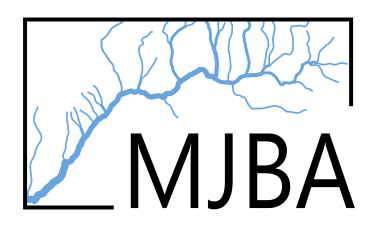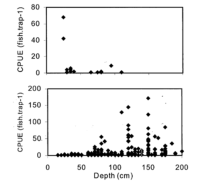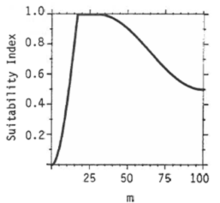Depth of Reach and Salish Sucker
mbakken
View all records in the stressor response library
Species Common Name
Salish Sucker
Latin Name (Genus species)
Catostomus sp.
Stressor Name
Water depth
Specific Stressor Metric
Mean depth of the reach
Stressor Units
cm
Vital Rate (Process)
CPUE
Geography
Lower Fraser Valley (British Columbia)
Detailed SR Function Description
We inferred a stepwise function with a threshold value of 70 cm based on the inference made in Pearson (2004) and Fisheries and Oceans Canada (2019). This is based on the inference from Fig 3.3 from Pearson (2004) pasted below (Figure 1) that Adult Salish sucker are generally most likely to be caught in habitats where the depth is greater than 70cm for at lest 50 contiguous meters (this is also the definition of critical habitat for Salish sucker. Edwards (1983) describes the relationship for lacustrine Longnose Dace (depth is in meters) and therefore, not applicable to Salish Sucker (Figure 2). However, it shows a sharp decline in habitat suitability at the threshold value and therefore, partly supports the shape of the final function.
Transferability of Function
As local adaptations are likely minimal among different Salish Sucker populations, we would not expect much variation in true tolerance among populations. This function should therefore be broadly applicable to all populations of the species, with the caveat that it is partly based on data from other related species.
Source of stressor Data
Data on length of reaches greater than 70cm deep is available for most (but not all) reaches in Bertrand, Pepin, Fishtrap Creeks, and the Salmon River, collected as part of Pearson (2004) and subsequent field work to define critical habitat for Salish sucker.
Note that this SR function will likely not be directly used to calculated cumulative effects in CEMPRA. Rather, the length or proportion of deep pool habitat meeting this criteria (i.e. the quantity of this specific critical habitat) will be treated as an input variable in the stressor magnitude table (see the matching SR function for proportion of deep pool habitat).
Note that this SR function will likely not be directly used to calculated cumulative effects in CEMPRA. Rather, the length or proportion of deep pool habitat meeting this criteria (i.e. the quantity of this specific critical habitat) will be treated as an input variable in the stressor magnitude table (see the matching SR function for proportion of deep pool habitat).
Function Type
step
Stressor Scale
linear
References Cited
Usoof, A.M. and Rosenfeld, J.S. 2024. Relationship between system capacity and mean water depth for Salish Sucker.
Edwards, E. A. 1983. Habitat Suitability Index Models: Longnose Sucker. U.S. Dept. Int., FishWildl. Serv. FWS/OBS-82/10.35.
Fisheries and Oceans Canada. 2019. Recovery strategy for the Salish Sucker ( Catostomus sp .) in Canada [Proposed]. 1st amendment. Species at Risk Act Recovery Strategy Series. Fisheries and Oceans Canada, Ottawa.
Pearson, M. P. 2004. The ecology, status and recovery prospects of Noonsack Dace (Rhinichthys Cataractae ssp.) and Salish Sucker (Catostomus sp.) in Canada. University of British Columbia.
Rosenfeld, J., M. P. Pearson, J. Miners, and K. Zinn. 2021. Effects of landscape-scale hypoxia on Salish sucker and salmonid habitat associations : implications for endangered 1233:1219–1233.
Edwards, E. A. 1983. Habitat Suitability Index Models: Longnose Sucker. U.S. Dept. Int., FishWildl. Serv. FWS/OBS-82/10.35.
Fisheries and Oceans Canada. 2019. Recovery strategy for the Salish Sucker ( Catostomus sp .) in Canada [Proposed]. 1st amendment. Species at Risk Act Recovery Strategy Series. Fisheries and Oceans Canada, Ottawa.
Pearson, M. P. 2004. The ecology, status and recovery prospects of Noonsack Dace (Rhinichthys Cataractae ssp.) and Salish Sucker (Catostomus sp.) in Canada. University of British Columbia.
Rosenfeld, J., M. P. Pearson, J. Miners, and K. Zinn. 2021. Effects of landscape-scale hypoxia on Salish sucker and salmonid habitat associations : implications for endangered 1233:1219–1233.
File Upload
Salish Sucker - Depth SR function documentation
(121.35 KB)
Salish Sucker - Depth CEMPRA SR Function
(154.8 KB)
Stressor Response csv data
Data_SS_Depth.csv
(154 bytes)
| Mean Depth (cm) | Mean System Capacity (%) | SD | low.limit | up.limit |
|---|---|---|---|---|
| 0.00 | 0 | 0 | 0 | 100 |
| 69.90 | 0 | 0 | 0 | 100 |
| 70.00 | 100 | 0 | 0 | 100 |
| 100.00 | 100 | 0 | 0 | 100 |
| 140.00 | 100 | 0 | 0 | 100 |
Stressor Response Chart


